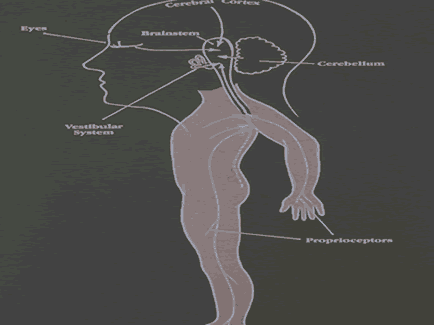|
|
Our Balance System
A person's sense of balance is
maintained by a complex interaction of four body systems[see
figure below]:
1. The inner ears (vestibular system)
2. The eyes
3. The brain (brainstem, cerebral cortex and cerebellum)
and
4. The spinal cord along with the joints and muscles of
the limbs (proprioceptors)
Sensations of dizziness, lightheadedness and unsteadiness may result from
disturbances of any one or a combination of these four systems.

Each system performs certain functions. The inner ear monitors the direction
of motions such as turning, stopping, and starting. The eyes monitor the
position of the body in space and also assist in the detection of the direction
of motion. The skin pressure receptors, such as the feet, monitor the stability
of the body in relationship to the ground. The muscle and joint receptors
monitor what body parts are moving. The brain and spinal cord process and
coordinate the information from all of these systems for maintenance of
balance.
The inner ear is that part of the ear that houses the balance chambers.
The inner ear is divided into two main compartments. One compartment is
the cochlea ("coke-lee-a") which is for hearing. The other compartment
consists of the balance chambers: the semicircular canals, the utricle and the saccule. The cochlea and all of the balance chambers are interconnected.
The organs within the inner ear are bathed in fluid and contain the delicate
nerve endings of balance and hearing.
The function of the balance system
As the head moves, the fluid in the balance chambers moves and pushes against
the balance nerve endings. The nerve endings register the change and
send electrical signals to the brain by way of the balance (vestibular)
nerve. The brain interprets this signal as head movement.
Each inner ear is continuously sending information to the brain regarding
the body's position. Balance is maintained by a continuous and equal signal
from both inner ears. When one inner ear is damaged, the unequal input
to the brain causes a type of dizziness known as vertigo.
The Anatomy of Balance
Dizziness, vertigo, and motion sickness all relate
to the sense of balance and equilibrium. Researchers in space and
aeronautical medicine call this spatial orientation, because it tells
the brain where the body is "in space:" what direction it is pointing,
what direction it is moving, and if it is turning or standing still.
Your sense of balance is maintained by a complex
interaction of the following parts of the nervous system:
- The inner ears (also called the labyrinth), which monitor the
directions of motion, such as turning, or forward-backward,
side-to-side, and up-and-down motions.
- The eyes , which monitor where the body is in space (i.e. upside
down, rightside up, etc.) and also directions of motion.
- The skin pressure receptors such as in the joints and spine,
which tell what part of the body is down and touching the ground.
- The muscle and joint sensory receptors , which tell what parts
of the body are moving.
- The central nervous system (the brain and spinal cord), which
processes all the bits of information from the four other systems
to make some coordinated sense out of it all.
|



